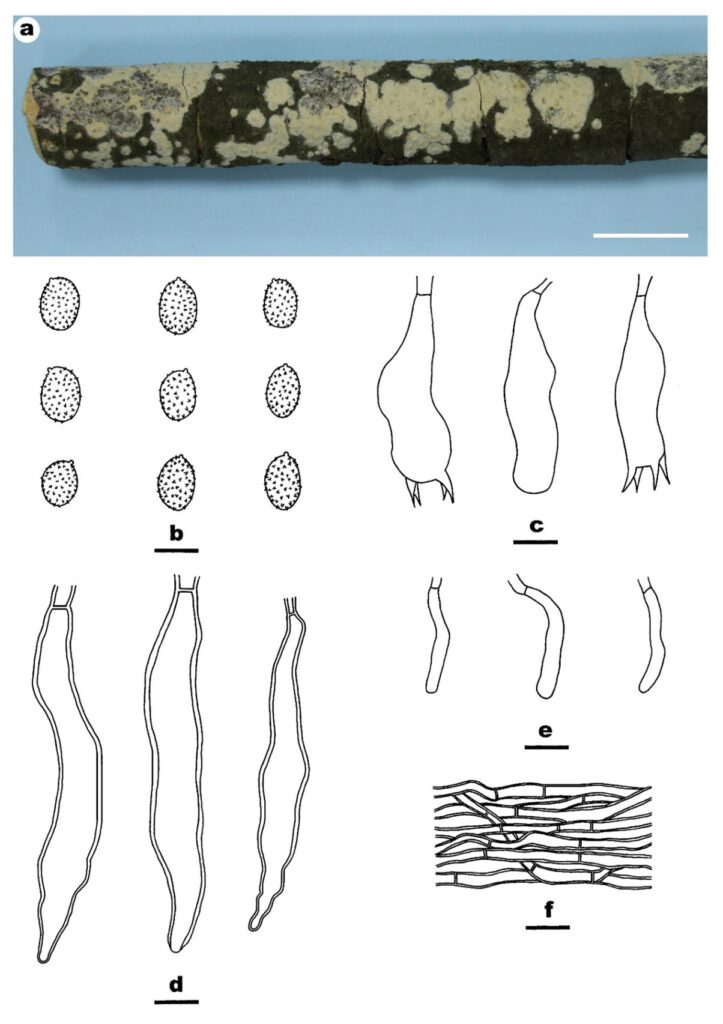Gloeocystidiopsis shenghuai S.H. He & Y.F. Cao, sp. nov.
MycoBank number: MB; Index Fungorum number: IF; Facesoffungi number: FoF 10788;
Description
Sexual state: Fruiting body – Basidiomata annual, resupinate, effused, closely adnate, inseparable, membranaceous to coriaceous, at first as small patches, later confluent up to 3 cm long, 1.5 cm wide, 200–300 µm thick. Hymenophore smooth, pale orange (5A3), light orange [5A(4–5)] to greyish orange [5B(3–5)], unchanged in KOH, uncracked; margin thinning out, indistinct, concolorous with hymenophore.
Microscopic structures – Hyphal system monomitic; all hyphae without clamps. Subiculum indistinct; hyphae colorless, slightly thick-walled, smooth, rarely branched, frequently septate, slightly agglutinated, more or less parallel to substrate, 1.8–2.6 µm in diam. Subhymenium distinct; hyphae colorless, thin- to slightly thick-walled, smooth, rarely branched, moderately septate, interwoven, 1.5–2.2 µm in diam. Gloeocystidia subfusiform to subulate, colorless, thick-walled, smooth, with one to several indistinct constrictions at the apex, embedded or slightly projecting, 60–80 × 10–14 µm. Hyphidia scattered, colorless, thin-walled, smooth, unbranched. Basidia subclavate, often with a constriction, colorless, thin-walled, smooth, with four sterigmata and a basal simple septum, 30–45 × 9–12 µm; basidioles dominant, in shape similar to basidia, but slightly smaller. Basidiospores ellipsoid to broadly ellipsoid, colorless, thin-walled, finely echinulate, strongly amyloid, acyanophilous, (9–) 10–12 × 7–8.5 (–8.9) µm, L = 11 µm, W = 7.9 µm, Q = 1.4 (n = 30/1).
Asexual state: not observed.
Material examined: CHINA, Guizhou Province, Bijie County, Bailidujuan Forest Park, on dead angiosperm branch, 5 July 2018, He 5411 (BJFC 026472, holotype, isotype in BJM).
Distribution: China
Sequence data: ITS: MW533083 (ITS5/ITS4); LSU: MW528919 (LROR/LR7)
Notes: Gloeocystidiopsis shenghuai was nested within the Gloeocystidiopsis lineage and is characterized by the large basidiospores, which can be used distinguish from all other species in the clade (≤ 8 µm long, ≤ 5 µm wide, Jülich 1982; Wu 1996; Boidin et al. 1997; Dai et al. 2017a).

Fig. 9. Gloeocystidiopsis shenghuai (BJFC 026472, holotype). a Basidiomata. b Basidiospores. c Basidia and a basidiole. d Gloeocystidia. e Hyphidia. f. Generative hyphae from subiculum. Scale bars: a = 1 cm, b–f = 10 µm.
